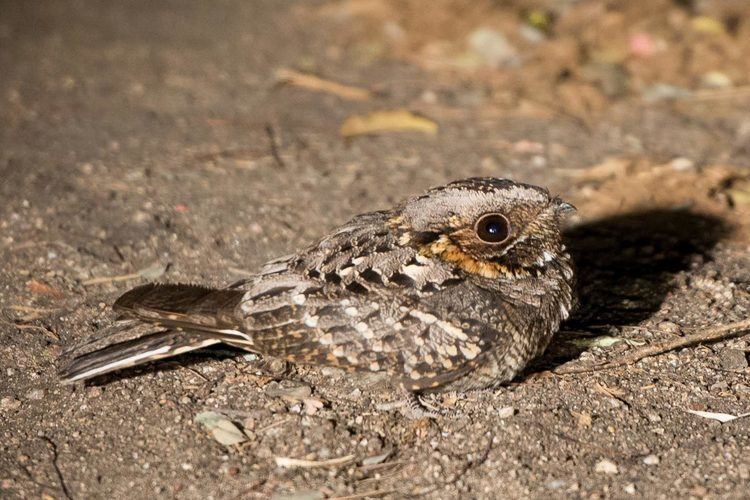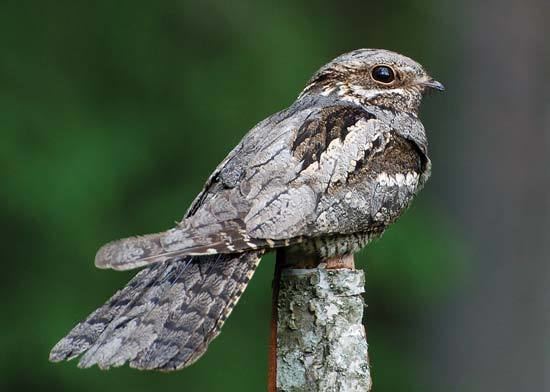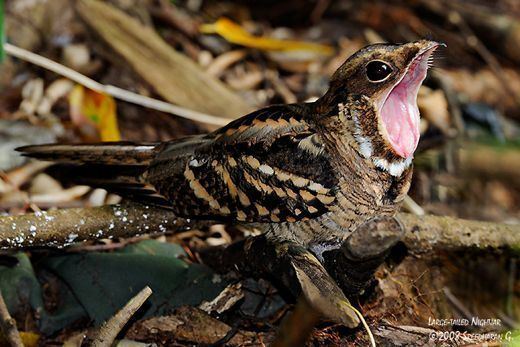Order Caprimulgiformes Higher classification Caprimulgiformes | Phylum Chordata Scientific name Caprimulgidae Rank Family | |
 | ||
Lower classifications | ||
Goatsucker or nightjar cute bird of the night
Nightjars are medium-sized nocturnal or crepuscular birds in the family Caprimulgidae, characterized by long wings, short legs and very short bills. They are sometimes called goatsuckers, due to the ancient folk tale that they sucked the milk from goats (the Latin for goatsucker is Caprimulgus). Some New World species are called nighthawks. Nightjars usually nest on the ground.
Contents
- Goatsucker or nightjar cute bird of the night
- Nightjar s in flight and at rest along a branch
- Conservation challenge
- Systematics
- References

The English word 'nightjar' originally referred to the European nightjar.
Nightjars are found around the world. They are mostly active in the late evening and early morning or at night, and feed predominantly on moths and other large flying insects.

Most have small feet, of little use for walking, and long pointed wings. Their soft plumage is cryptically coloured to resemble bark or leaves. Some species, unusual for birds, perch along a branch, rather than across it. This helps to conceal them during the day.
The common poorwill, Phalaenoptilus nuttallii, is unique as a bird that undergoes a form of hibernation, becoming torpid and with a much reduced body temperature for weeks or months, although other nightjars can enter a state of torpor for shorter periods.

Nightjars lay one or two patterned eggs directly onto bare ground. It has been suggested that nightjars will move their eggs and chicks from the nesting site in the event of danger by carrying them in their mouths. This suggestion has been repeated many times in ornithology books, but surveys of nightjar research have found very little evidence to support this idea.

Nightjar s in flight and at rest along a branch
Conservation challenge

Working out conservation strategies for some species of nightjar presents a particular challenge common to other hard-to-see families of birds; in a few cases, humans do not have enough data on whether a bird is rare or not. This has nothing to do with any lack of effort. It reflects, rather, the difficulty in locating and identifying a small number of those species of birds among the 10,000 or so that exist in the world, given the limitations of human beings. A perfect example is the Vaurie's nightjar in China's south-western Xinjiang. It has been seen for certain only once, in 1929, a specimen that was held in the hand. Surveys in the 1970s and 1990s failed to find it. It is perfectly possible that it has evolved as a species that can really be identified in the wild only by other Vaurie's nightjars, rather than by humans. As a result, scientists do not know whether it is extinct, endangered, or even locally common.
Systematics
Traditionally, nightjars have been divided into three subfamilies: the Caprimulginae, or typical nightjars with about 80 species, and the Chordeilinae, or nighthawks of the New World with about 19 species. The two groups are similar in most respects, but the typical nightjars have rictal bristles, longer bills, and softer plumage. In their pioneering DNA-DNA hybridisation work, Sibley and Ahlquist found that the genetic difference between the eared nightjars and the typical nightjars was, in fact, greater than that between the typical nightjars and the nighthawks of the New World. Accordingly, they placed the eared-nightjars in a separate family: Eurostopodidae, but the family has not yet been widely adopted.
Subsequent work, both morphological and genetic, has provided support for the separation of the typical and the eared nightjars, and some authorities have adopted this Sibley-Ahlquist recommendation, and also the more far-reaching one to group all the owls (traditionally Strigiformes) together in the Caprimulgiformes. The listing below retains a more orthodox arrangement, but recognises the eared-nightjars as a separate group. For more detail and an alternative classification scheme, see Caprimulgiformes and Sibley-Ahlquist taxonomy.
Subfamily Chordeilinae (nighthawks)
Subfamily Caprimulginae — (typical nightjars)
Subfamily Eurostopodinae — (eared nightjars)
Also see a list of nightjars, sortable by common and binomial names.
